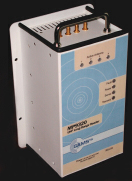Sep 18, 2003Sept. 18, 2003 - SAMSys Technologies, a Toronto-based company that makes RFID readers, has been granted a U.S. patent for a "System for Multi-Standard RFID Tags." Cliff Horwitz, chairman and chief executive officer of SAMSys, says the patent includes several claims that generally cover the concept and architecture for multi-frequency, multi-protocol readers.
"In a nutshell, the claims cover both the concept and the manner of implementation—the actual hardware design itself—of a reader capable of interrogating a disparate group of tags, which might operate at varying frequencies and different protocols," Horwitz says.
The patent, which was filed in 2000, raises the possibility that other companies designing or selling multi-frequency, multi-protocol readers could be sued by SAMSys is if they don't agree to pay SAMSys a licensing fee or royalty.
"Some of the competitive designs that have been described, we believe, borrow on our intellectual property, and it behooves us, if it is our intention to defend and support the intellectual property, to make it clear to everyone that a set of claims is out there," says Horwitz. "That is what we are doing. No one can claim they didn't know about it."
The claims would likely have to be tested in court, but SAMSys would prefer to seek commercial arrangements with other reader makers. "We're not playing a litigious game here, and it's not our intention to be confrontational or obstructive," Horwitz says. "All of us who have spent a lot of capital in developing a product portfolio and technology in a general sense have an obligation to our shareholders. It would be irresponsible of us not to try to take full advantage of what we've been doing. We are not going to sit back and allow others to claim this invention as their own when it is what SAMSys has been all about for years."
SAMSys’ philosophy has been to offer readers that can operate at different frequencies and read tags based on different standards. That gives companies the flexibility to use the right frequency for the application and prevents the readers from becoming obsolete when standards change.
At this week's EPC Symposium in Chicago, SAMSys introduced a new UHF EPC reader, the MP 9320 Version 2.0. The reader is a refinement to the UHF reader released in June. It can read tags based on the Auto-ID Center's Class 1 specification. Horwitz says it will support Class 0 when intellectual property issues surrounding Class 0 are worked out. The reader also supports ISO 18000-6 A and ISO 18000-6 B, emerging international standards for UHF systems.
The reader can operate at 915 MHz, the UHF band used in the United States, and 868 MHz, the band used in Europe. It also supports four single antennas that can be deployed in array for one read point or separately to cover four different read points.
"Other readers on the market have a separate transmit antenna and receive antenna for each read point," says Horwitz. "We have facilitated a single transmit and receive antenna at each read point. Antenna cost is going to be critical in the ultimate deployment. We are talking about halving the antenna cost, while doubling the read points that the reader is capable of."
Another new feature is the ability to limit the power output of each antenna, which enables the user to effectively adjust the read range. This is important because you may have an antenna above a dock door where you want to have as much penetration through a pallet coming through the door. But you might want to limit the power of readers on the side of dock doors so they are not reading tags on items coming through neighboring doors.
The new reader is available now and costs around $3,000, excluding antennas.
Only three weeks left until RFID Journal University in San Francisco. Seats are limited. To register please visit RFID Journal University


